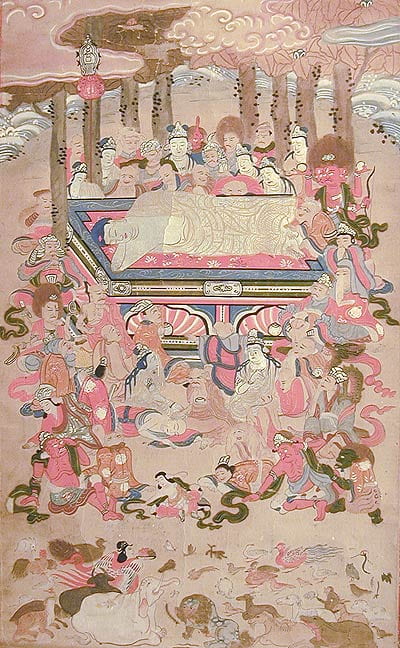Buddha: The Perfected One
Suggested Grade Level: Upper Elementary (Grades 3-5), Middle School (Grades 6-8)
Subject: Language Arts
Estimated Time: 1-2 class sessions
The Death of the Buddha
Japan, 18th-19th century
Ink and colors on paper
Pacific Asia Museum Collection
Gift of Mr. Bill Kendall, 1994.48.2
Introduction
For hundreds of years, Buddhists have passed along the teachings of Siddhartha Gautama, the Buddha, through stories and sacred verses that they memorized and wrote down. They have also created artworks that help believers understand his teachings.
One of the ideas that the Buddha taught is that our souls have lived in many bodies, animal and human. He himself had lived numerous lives, and the stories of these previous lives (also called incarnations) are called Jataka tales. Although it might sound like fun to have been a crow or a snail in a past life, the Buddha taught that we all suffer and that the goal of Buddhism is to end suffering. By truly understanding about life and suffering and by obtaining perfect peace, we can achieve Nirvana, which is the end to suffering. Once we achieve Nirvana, or enlightenment, our souls are liberated from the cycle of rebirth/reincarnation.
Lesson Objectives
- Understand the meaning of reincarnation and nirvana, two basic tenets of Buddhism.
- Learn about the Buddha.
- Use an artwork from the Pacific Asia Museum as the basis for understanding these ideas and for engaging student critical thinking and writing.
Key Terms
Enlightenment
Historical Buddha
Incarnations
Jataka tales
Nirvana
Reincarnation
Soul
Suffering
Tale
Suggested reading
(All for ages 7-10)
Chodzin, Sherab, The Wisdom of Crows and other Buddhist Tales. New York: Tricycle Press.
Demi, Buddha. New York: Henry Holt, 1996.
Demi, Buddha Stories. New York: Henry Holt, 1997.
Lee, J. M., I Was Once a Monkey: Stories Buddha Told. New York: Farrar, Straus, and Grioux, 1999.
Witwer, Julia, The Princess Who Overcame Evil: A Jataka Tale. New York: Dharma Publishing, 2001.
Discussion
The Buddha achieved enlightenment after he had spent many years meditating and thinking about life. To help the rest of us this reach enlightenment, he spent several decades teaching what he had come to understand and delayed achieving full Nirvana. When he was more than 80 years old, however, the time had come for even the Buddha to die and achieve full enlightenment. This artwork shows his students, friends, the animals in the forest, and even gods and goddesses who were all there in his last moments on earth.
Ask students to look closely at this artwork:
1. What animals do they see?
2. What kinds of people?
3. Are there any beings that appear to be neither animals nor people? What are they? (deities)
4. What emotions are the animals and people feeling? What does the Buddha feel?
Activities
1. Ask students to write a short paragraph or a story describing the scene in The Death of Buddha. What do they see in the artwork? What is happening? Why do they think so?
2. Explain about the concept of Enlightenment. Have they ever been confused and then figured something out? Or bumped into something in the dark, turned on the light, and realized what they’d bumped into? Ask students to write about this experience and draw comparisons to the Buddha’s enlightenment.
3. Discuss reincarnation and read some of the Jataka tales online or in the books listed above. Ask students to write their own stories about who or what they might have been or be in a former or future life. Why did they choose this incarnation? Would their friends or family members have the same incarnations?
Standards
California State Framework for Reading and Language Arts
Reading Comprehension
Literary Response and Analysis
